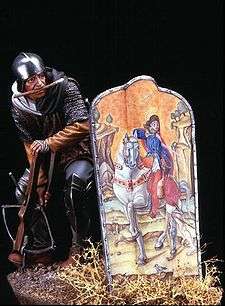Pavise
A pavise (or pavis, pabys, or pavesen) was an oblong shield used during the late 14th to early 16th centuries. Often large enough to cover the entire body, it was used by archers and infantry soldiers.[1] The name comes from the city of Pavia, Italy. Of European origin, the pavise was large, square and convex. A smaller version for hand-to-hand combat and for wearing on the backs of men-at-arms was also made. The pavise is characterized by its prominent central ridge. The concept of using a shield to cover an archer dates to at least the writing of Homer's Iliad, where Ajax used his shield to cover his half-brother Teucer, an archer, while he would "peer round" and shoot arrows.[2]

The pavise was primarily used by archers and crossbowmen in the Middle Ages, particularly during sieges. It was carried by a pavisier, usually an archer, or, especially for the larger ones, by a specialist pavise-bearer. The pavise was held in place by the pavisier or sometimes deployed in the ground with a spike attached to the bottom. While reloading their weapons, archers and crossbowmen would crouch behind them to shelter against incoming missile attacks.
Pavises were often painted with the coat of arms of the town where they were made, and sometimes stored in the town arsenal for when the town came under attack. Religious icons such as St. Barbara and St. George were featured on the front of pavises. Even the Hussite chalice was featured on pavises during the Hussite Wars. Most pavises were covered in a coarse, carpet-base-like canvas, before being painted with oil and egg-based paints. Only 200 or so exist today but many were present in the period.
A related term, pavisade or pavesade, refers to a decorative row of shields or a band of canvas hung around a sailing vessel to prevent an opponent from observing the activities of those on board and to discourage boarding.
Pavesarii
The Genoese, an internationally recognized elite, made use of the pavise, utilizing pavesarii (shield bearers). Having over three crossbowmen per pavise suggests that they took turns using the pavise as cover and were used primarily in static or defensive formations.[3]
See also
References
- "the definition of pavise". Dictionary.com. Retrieved 15 May 2018.
- Cf. Book VIII
- Nicolle, David (15 October 2009). "Military History Books - Failure of an Elite - The Genoese at Crécy". Osprey Publishing. WaybackMachine. Archived from the original on 15 October 2009. Retrieved 15 May 2018.
External links
| Wikimedia Commons has media related to Pavese shield. |
- 15th Century Pavises (myArmoury.com forum topic)
- The Shield: An Abridged History of its Use and Development (myArmoury.com article)